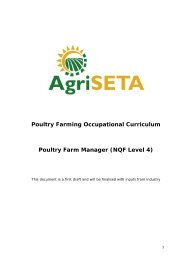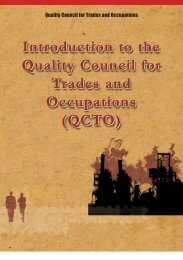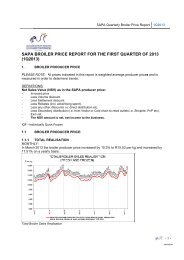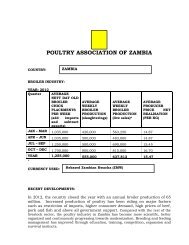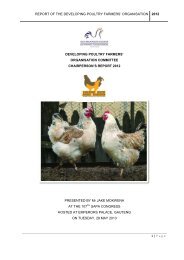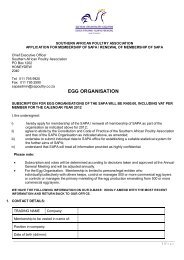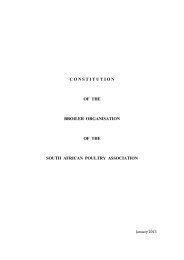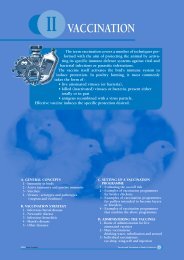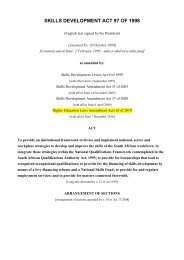Mycoplasma, chronic respiratory disease of poultry
Mycoplasma, chronic respiratory disease of poultry
Mycoplasma, chronic respiratory disease of poultry
You also want an ePaper? Increase the reach of your titles
YUMPU automatically turns print PDFs into web optimized ePapers that Google loves.
Chronic <strong>respiratory</strong> <strong>disease</strong> <strong>of</strong> <strong>poultry</strong><br />
News<br />
Sunday, 21 Oct 2012<br />
<strong>Mycoplasma</strong>s are present in every species including avian but various types<br />
<strong>of</strong> <strong>Mycoplasma</strong>s are present in <strong>poultry</strong>, among which four pathogenic<br />
<strong>Mycoplasma</strong>s are <strong>Mycoplasma</strong> gallisepticum (MG), <strong>Mycoplasma</strong> synoviae<br />
(MS), <strong>Mycoplasma</strong> meleagridis (MM) and <strong>Mycoplasma</strong>s iowae (MI).<br />
MG is the most important pathogen <strong>of</strong> <strong>poultry</strong> causing Chronic Respiratory Disease<br />
(CRD), infectious sinusitis and air sacculitis in <strong>poultry</strong>.<br />
<strong>Mycoplasma</strong> gallisepticum is the most economically significant mycoplasmal pathogen<br />
<strong>of</strong> <strong>poultry</strong>. The major economic losses due to CRD are reduced growth rate and feed<br />
conversion, decrease egg production in breeders and commercial layers (15-25 eggs per<br />
hen housed in 60 weeks), decrease hatchability, reduced egg selection pressure because<br />
<strong>of</strong> the reduced hatching egg availability, reduced day old chick quality, increased chick<br />
mortality because <strong>of</strong> the exacerbated consequence <strong>of</strong> concurrent infection,<br />
condemnation and downgrading <strong>of</strong> carcasses, increased medication cost, costly control<br />
measures involving biosecurity, vaccination, costly eradication measures involving<br />
depopulation and site cleaning, costly monitoring programs involving serology and PCR.<br />
The carcasses <strong>of</strong> birds sent to slaughter may also be downgraded. M. gallisepticum<br />
infections are notifiable to the World Organization for Animal Health (OIE).<br />
Bird suffering from avian mycoplasmosis showed clinical signs like rales, coughing, nasal<br />
discharge, and air sacculitis with low mortality in uncomplicated cases in chickens. Wide<br />
diversity <strong>of</strong> clinical manifestation primarily pulmonary with coughing and <strong>respiratory</strong><br />
distress in chickens but decrease in egg production can occur.<br />
Different clinical signs <strong>of</strong> the <strong>respiratory</strong> system include coughing, sneezing, rales, nasal<br />
discharge and conjunctivitis. Gross pathological lesion consists <strong>of</strong> mucoid to<br />
mucupurrulent exudates in trachea, bronchi, air sacs, nasal cavities but even in the<br />
absence <strong>of</strong> apparent clinical signs, the economic impact may be significant.<br />
M. gallisepticum is transmitted during close contact between birds as well as on fomites.<br />
Aerosol spread occurs over short distances and can be responsible for transmission<br />
within a flock. M. gallisepticum is also transmitted vertically in eggs. Shedding in the egg<br />
can vary; egg transmission is more frequent in birds infected Avian Mycoplasmosis<br />
(<strong>Mycoplasma</strong> gallisepticum) during laying than in birds infected before they mature.<br />
Infected birds carry M. gallisepticum for life, and can remain asymptomatic until they<br />
are stressed.<br />
The diagnosis <strong>of</strong> mycoplasma can be done on the basis <strong>of</strong> history, clinical signs, isolation,<br />
culturing, morphological, biochemical, serological and molecular techniques. Advanced<br />
techniques such as Amplified Fragment Length Polymorphism (AFLP) technique,
Pulsed-Field Gel Electrophoresis (PFGE), Random Amplified Polymorphic DNA<br />
(RAPD), conventional Polymerase Chain Reaction (PCR) and Real Time PCR (RT PCR)<br />
have also been applied for classification and analysis <strong>of</strong> the genetic relationships among<br />
different isolates <strong>of</strong> <strong>Mycoplasma</strong>s. Due to impact <strong>of</strong> MG in <strong>poultry</strong> flocks, several<br />
countries try to eliminate it with some achievements through active surveillance,<br />
antibiotics and manage mental practices. With development <strong>of</strong> RSPA (Rapid Spot Plate<br />
Agglutination), ELISA (Enzyme Linked Immunosorbent Assay), HI (Haemagglutination<br />
Inhibition) tests for rapid assessment <strong>of</strong> serum antibodies against MG, or PCR used for<br />
confirmation <strong>of</strong> <strong>Mycoplasma</strong> getting great attention to control it.<br />
M. gallisepticum can be controlled by heat treatment or tylosin to eliminate egg<br />
transmission from valuable breeding animals. Biosecurity measures are important in<br />
preventing transmission on fomites.<br />
Wild or pet birds can also carry M. gallisepticum, and should be excluded from <strong>poultry</strong><br />
operations. Infections can be eliminated from a farm by depopulation <strong>of</strong> the flock,<br />
followed by thorough cleaning and disinfection <strong>of</strong> the premises. Most commonly used<br />
disinfectants are thought to be effective for M. gallisepticum. Recommended<br />
disinfectants for buildings and equipment include phenolic or cresylic acid disinfectants,<br />
hypochlorite, and 0.1% glutaraldehyde. <strong>Mycoplasma</strong>s are typically fragile and only<br />
survive in the environment for a few days; birds can be re–introduced after 2 weeks.<br />
Vaccination is generally only employed where keeping the flocks free <strong>of</strong> MG are not<br />
possible. Live attenuated strains such as ts11, MG 6/85 have been tested for use in layers<br />
and breeding stock with varying levels <strong>of</strong> residual virulence, immunity. Failure <strong>of</strong><br />
imported vaccine to provide protection against the local infectious agents may<br />
principally due to immunological and antigenic reasons.<br />
Dr Mushtaq Ahmad, Pr<strong>of</strong> Dr Masood Rabbani, UVAS, Lahore<br />
Source: Pakistan Times



